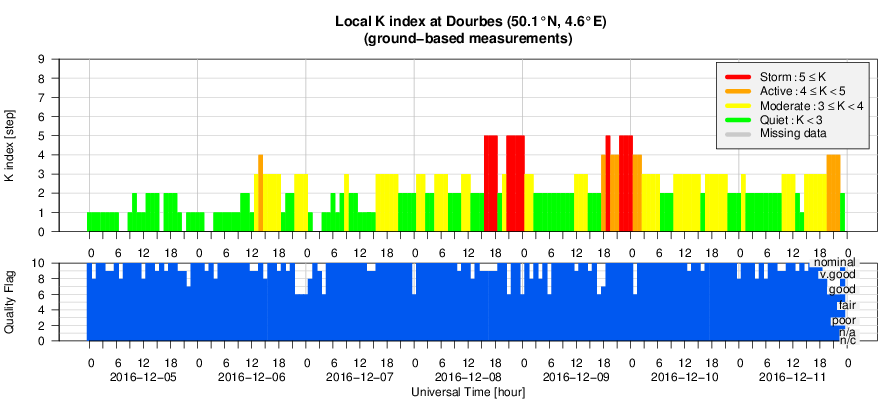- Table of Content
- 1.ESWW13 Forecas...
- 2.PROBA2 Observa...
- 3.Review of sola...
- 4.The Internatio...
- 5.Review of geom...
- 6.Geomagnetic Ob...
- 7.Review of iono...
- 8.Future Events
2. PROBA2 Observations (5 Dec 2016 - 11 Dec 2016)
3. Review of solar activity
4. The International Sunspot Number
5. Review of geomagnetic activity
6. Geomagnetic Observations at Dourbes (5 Dec 2016 - 11 Dec 2016)
7. Review of ionospheric activity (5 Dec 2016 - 11 Dec 2016)
8. Future Events
ESWW13 Forecasts: the movies
Space weather forecast services are a way to mitigate space weather impacts. At ESWW13, 5 forecast centers gave the participants a live space weather update over the previous 24h and a forecast for the next 24 hours.
Here are the movies: http://www.stce.be/esww13/liveforecast.php
with in the leading role: SeNMEs, SIDC, BGS, SWPC and MOSWOC.

PROBA2 Observations (5 Dec 2016 - 11 Dec 2016)
Solar Activity
Solar flare activity fluctuated between very low and low during the week.
In order to view the activity of this week in more detail, we suggest to go to the following website from which all the daily (normal and difference) movies can be accessed: http://proba2.oma.be/ssa
This page also lists the recorded flaring events.
A weekly overview movie can be found here http://proba2.oma.be/swap/data/mpg/movies/weekly_movies/weekly_movie_2016_12_05.mp4(SWAP week 350).
Details about some of this week’s events, can be found further below.
If any of the linked movies are unavailable they can be found in the P2SC movie repository here http://proba2.oma.be/swap/data/mpg/movies/
Thusday Dec 06
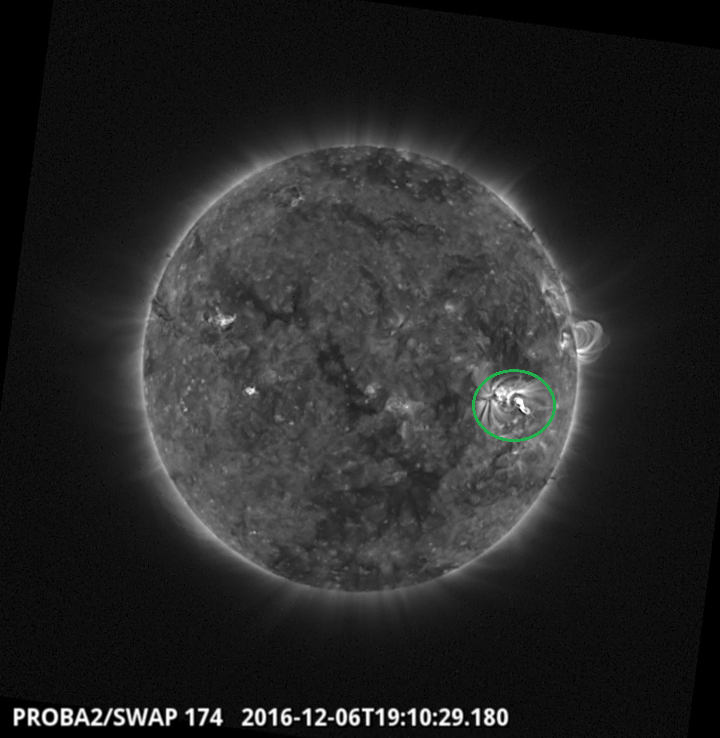
on 2016-Dec-06, an eruption was observed by SWAP in the west part of the Sun at 19:10. This active region is the most active one this week.
Find a movie of the event here (SWAP movie)http://proba2.oma.be/swap/data/mpg/movies/20161206_swap_movie.mp4
Friday Dec 09
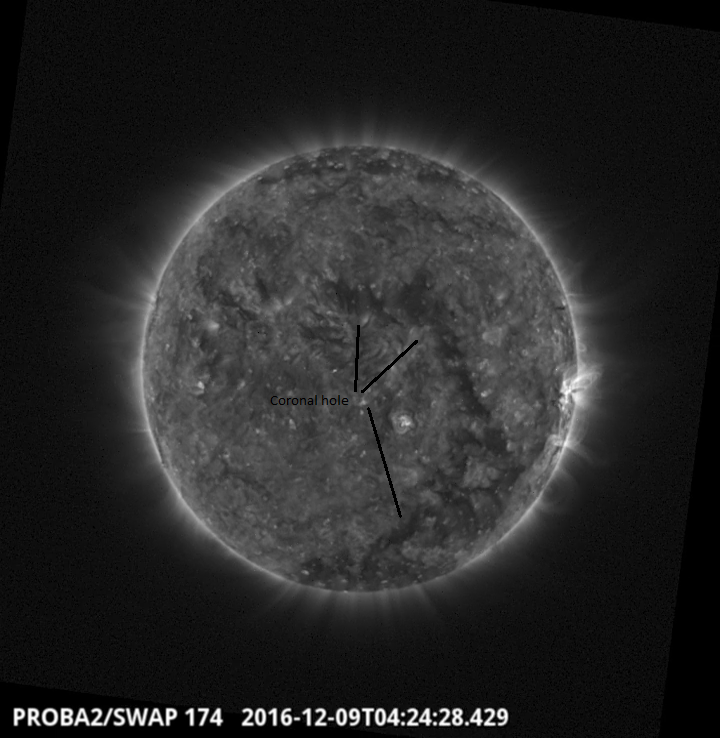
A coronal hole stretching from the northern hemisphere to the south pole has dominated the solar disk during the whole week.
Find a movie of the event here (SWAP movie)http://proba2.oma.be/swap/data/mpg/movies/20161209_swap_movie.mp4
Saturday Dec 10
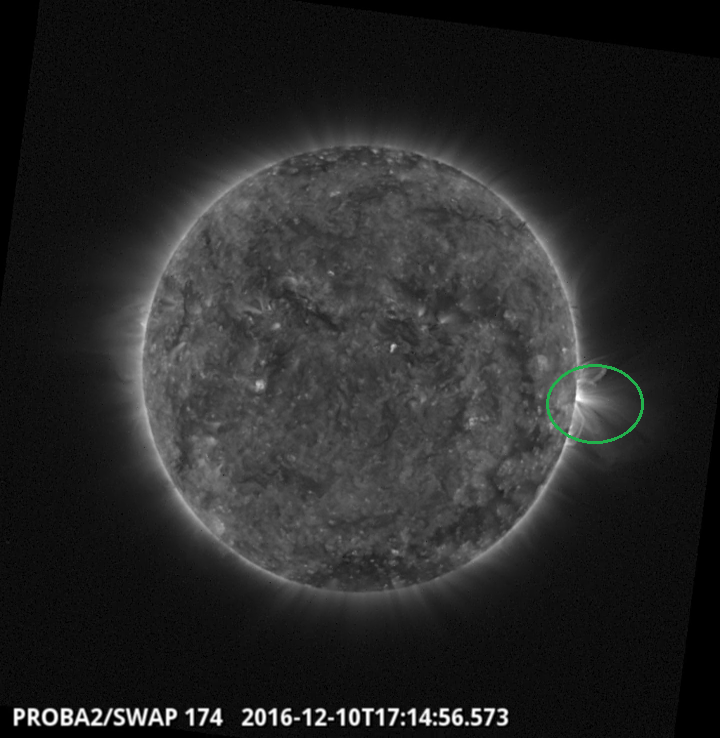
On Dec 10, an eruption was observed on the West Limb at 17h15.
Find a movie of the event here (SWAP movie)http://proba2.oma.be/swap/data/mpg/movies/20161210_swap_movie.mp4
Review of solar activity
Solar activity was low with 2 C class flares. The largest was a C4.0 class flare at 17:15 UT on 10 December.
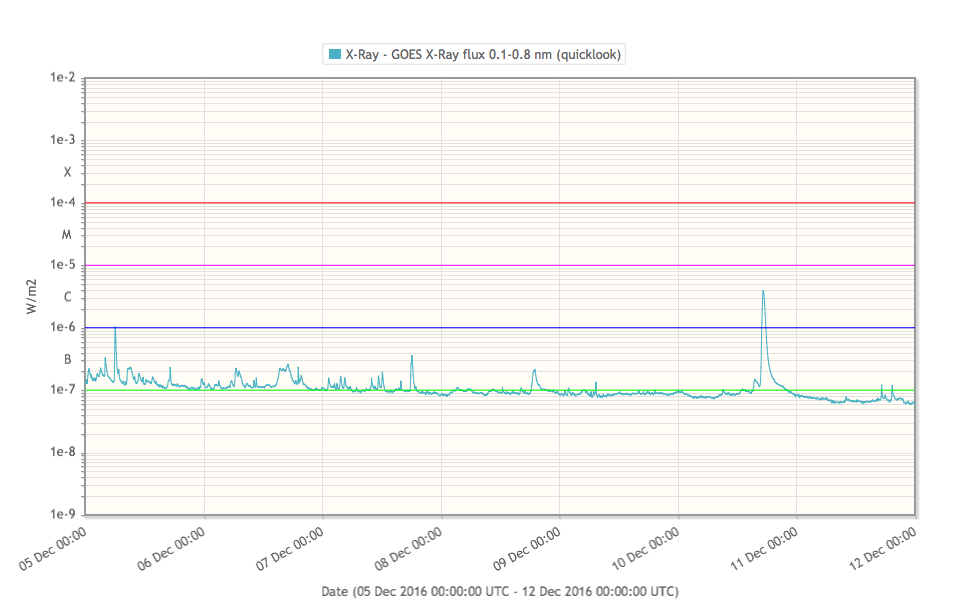
Active Region 2615 has been the most active region producing both C class flare.
See the SDO/HMI image from 5 December in visible light:
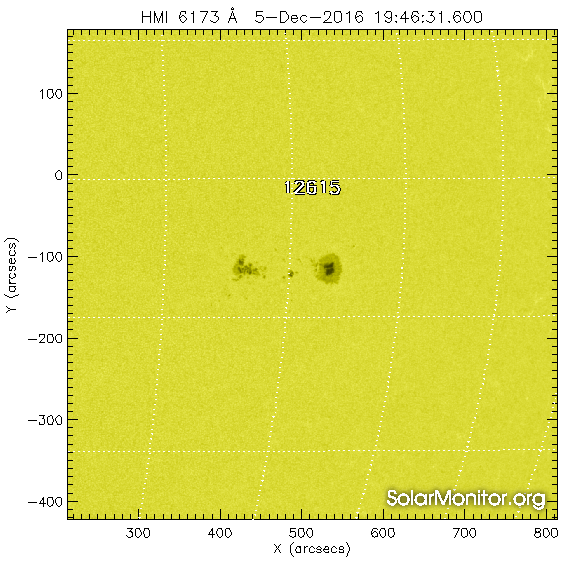
Region 2615 rotated over the solar limb on 10 December leaving the photospheric solar disk spotless.
Solar protons have remained at background levels over the past week. No Earth directed CMEs were detected over the past week.
The International Sunspot Number
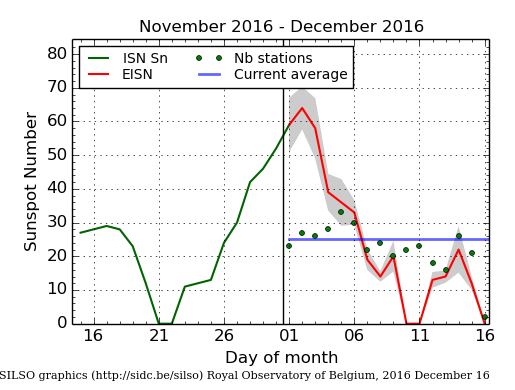
The daily Estimated International Sunspot Number (EISN, red curve with shaded error) derived by a simplified method from real-time data from the worldwide SILSO network. It extends the official Sunspot Number from the full processing of the preceding month (green line). The plot shows the last 30 days (about one solar rotation). The horizontal blue line shows the current monthly average, while the green dots give the number of stations included in the calculation of the EISN for each day.
Review of geomagnetic activity
The solar wind speed has fluctuated between 275 and 750 km/s over the past week. The total magnetic field strength has fluctuated between 2 and 20 nT, peaking on 8 December. The Bz component fluctuated between -10 and +20 nT.
Geomagnetic conditions ranged between Kp index 1-5 (NOAA) and local K index 0-5 (Dourbes) over the past week, and have been enhanced throughout the week due to the negative Bz and high speed solar wind generated from a large Southern polar trans-equatorial coronal hole (CH) with a negative polarity (in-ward, Phi between 270 and 360°).
This region created enhanced solar wind conditions due to influences from the associated Co-Rotating-Interaction Region (CIR) with a magnetically and particle-wise compressed plasma and the subsequent CH High Speed Stream (HSS).
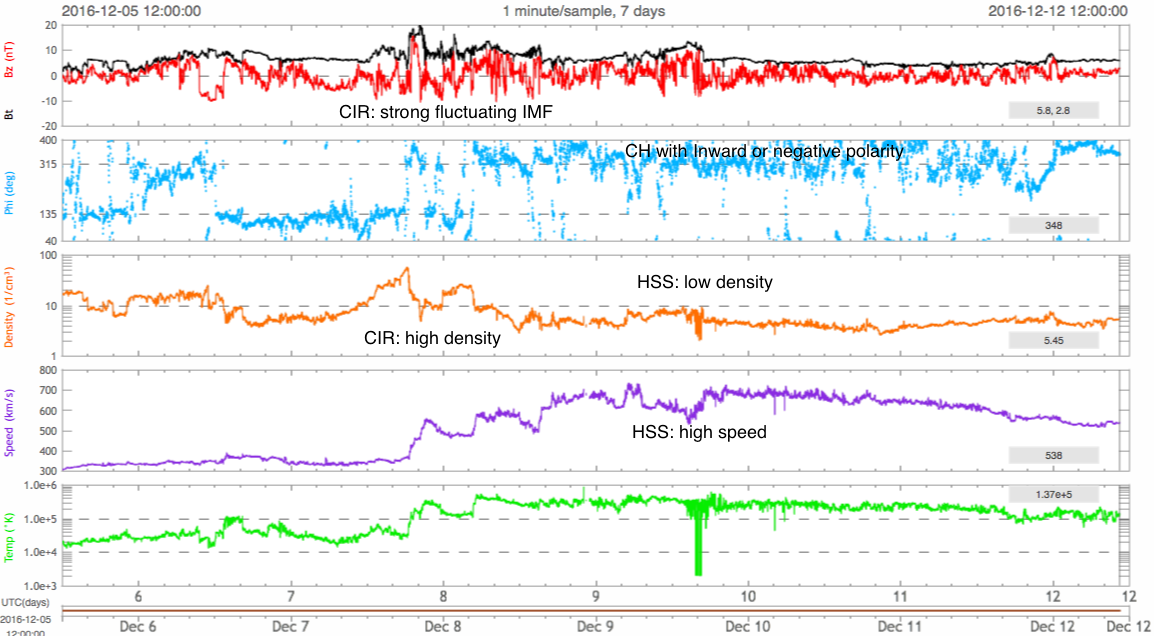
Review of ionospheric activity (5 Dec 2016 - 11 Dec 2016)
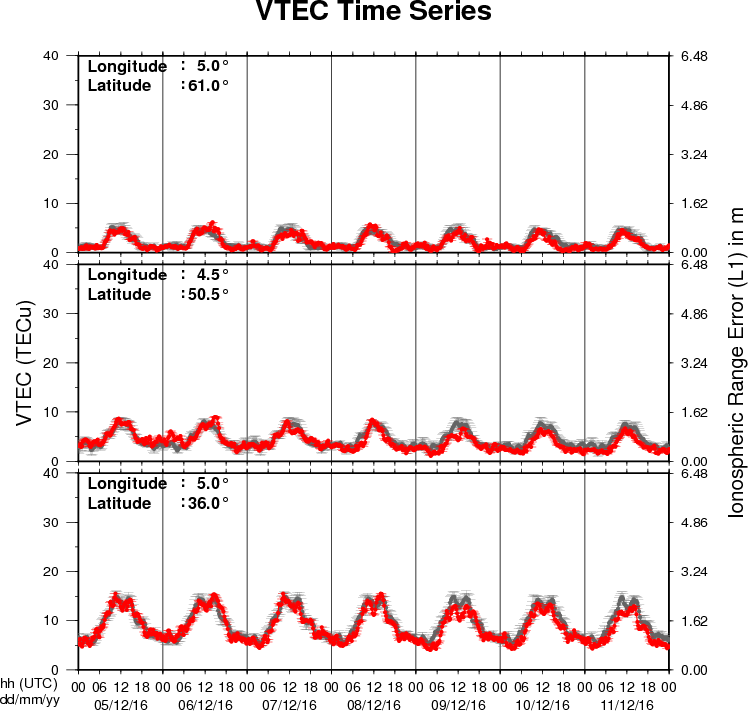
The figure shows the time evolution of the Vertical Total Electron Content (VTEC) (in red) during the last week at three locations:
a) in the northern part of Europe(N61°, 5°E)
b) above Brussels(N50.5°, 4.5°E)
c) in the southern part of Europe(N36°, 5°E)
This figure also shows (in grey) the normal ionospheric behaviour expected based on the median VTEC from the 15 previous days.
The VTEC is expressed in TECu (with TECu=10^16 electrons per square meter) and is directly related to the signal propagation delay due to the ionosphere (in figure: delay on GPS L1 frequency).
The Sun's radiation ionizes the Earth's upper atmosphere, the ionosphere, located from about 60km to 1000km above the Earth's surface.The ionization process in the ionosphere produces ions and free electrons. These electrons perturb the propagation of the GNSS (Global Navigation Satellite System) signals by inducing a so-called ionospheric delay.
See http://stce.be/newsletter/GNSS_final.pdf for some more explanations ; for detailed information, see http://gnss.be/ionosphere_tutorial.php
Future Events
For more details, see http://www.spaceweather.eu/en/event/future
4th SOLARNET Meeting: The Physics of the Sun from the Interior to the Outer Atmosphere, in Lanzarote (Spain)
Start : 2017-01-16 - End : 2017-01-20
The IV SOLARNET MEETING 'The physics of the Sun from the
interior to the outer atmosphere' will take place in Lanzarote
(Spain) from 16th to 20th of January 2017, organized by the
Instituto de AstrofÃsica de Canarias (IAC).
SOLARNET (High-resolution Solar Physics Network) is an EU-FP7
project coordinated by IAC with the aim of bringing together and
integrating the major European research infrastructures in the
field of high-resolution solar physics. SOLARNET involves all
pertinent European research institutions, infrastructures, and data
repositories. Networking activities, access to first-class
infrastructures and joint research and development activities are
being covered under SOLARNET to improve, in quantity and quality,
the service provided by this European community.
The purpose of this conference is to provide a coherent picture
of the Sun as a single physical system playing all the underlying
physical processes measured and observed in the solar atmosphere to
date.
Website:
http://www.iac.es/congreso/solarnet-4meeting/
Solar Orbiter Workshop 7: Exploring the solar environs in Granada, Spain
Start : 2017-04-03 - End : 2017-04-06
This event will be hosted by the Instituto de Astrofisica de
Andalucia - CSIC. Please mind that on April 7th the 20th SWT
meeting will take place at the same venue.
Website: Unkown
